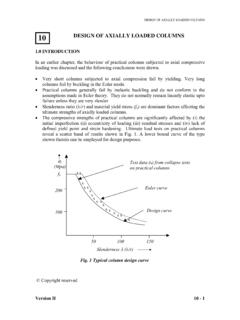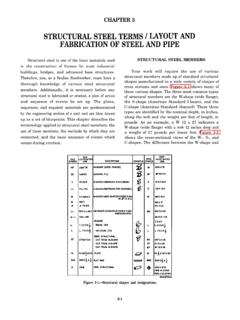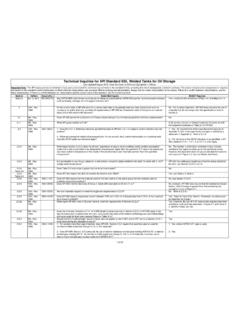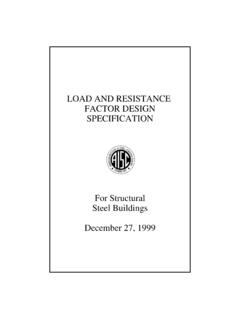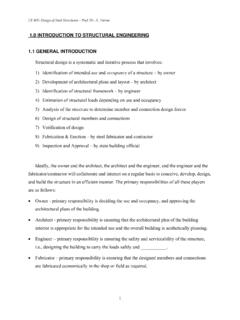Transcription of TABLES FOR STEEL CONSTRUCTIONS
1 TABLES FOR STEEL CONSTRUCTIONS BY Prof. Dr. MOUSTAFA KORASHY TABLES FOR STEEL CONSTRUCTIONS BY Prof. Dr. MOUSTAFA KORASHY CHECKED BY Dr. SHERIF IBRAHIM Eng. MOHAMED KORASHY 2001 CONTENTS List of symbols i Introduction ii Hot Rolled Sections 1 Combined Hot Rolled Sections 26 Cold Formed Sections
2 46 Combined Cold Formed Sections 50 Bolts 55 Sample of Corrugated Sheets 66 Accessories 76 Cranes 79 Welding Symbols 86 Miscellaneous 90 M.
3 Korashy iLIST OF SYMBOLS a (mm): Length of long leg for unequal angle. b (mm): Length of short leg for unequal angle, or flange width. b1 (mm): Width of upper flange for unsymmetrical welded I-sections. b2 (mm): Width of Lower flange for symmetrical welded I-sections. c (mm): Height of curved part including flange thickness for channel and I-sections. D (mm): Outer diameter of pipe. d (mm): Height of web for built -up I-sections. dmax. (mm): Maximum diameter of bolt to be used. e (mm): Distance measured from outer surface to neutral axis of section. ex (mm): Distance from bottom surface to X-X axis.
4 Ey (mm): Distance from outer surface to Y-Y Axis. h (mm): Height of section. I (cm4): Moment of inertia for symmetrical section. Iu (cm4): Moment of inertia about U-U axis. Iv (cm4): Moment of inertia about V-V axis. Ix (cm4): Moment of inertia about X-X axis. Iy (cm4): Moment of inertia about Y-Y axis. Iy upper flange (cm4): Moment of inertia for upper flange about Y-Y axis. J (cm4): Torsion constant. r (mm, cm): Radius of inner fillet for cold formed section, or Radius of gyration for symmetrical section. r1 (mm): Radius of fillet between web and flange. ru (cm): Radius of gyration about U-U axis.
5 Rv (cm): Radius of gyration about V-V axis. rx (cm): Radius of gyration about X-X axis. ry (cm): Radius of gyration about Y-Y axis. s (mm): Thickness of web, or Thickness of angle leg S (cm3): Elastic modulus of section. Sv (cm3): Elastic modulus of section about V-V axis. Sx (cm3): Elastic modulus of section about X-X axis. Sxb (cm3): Elastic modulus of bottom extreme fibers about X-X axis. Sxt (cm3): Elastic modulus of top extreme fibers about X-X axis. M. Korashy iiSy (cm3): Elastic modulus of section about Y-Y axis. Sy upper flange (cm3): Elastic modulus of upper flange about Y-Y axis.
6 T (mm): Thickness of flange, or Wall thickness. tG (mm): Thickness of gusset plate. u1, u2 (cm): Distance between outer fibers of an angle to V-V axis. Um (m2/m\): Surface area per unit length. Ut (m2/t): Surface area per unit weight. v, v1,&v2 (cm): Distance between outer fibers of an angle to U-U axis. w, w1 (mm): Distance determining bolt hole location relative to the section. Xm (cm): Distance between centroid of a channel and its shear center. iii Introduction The aim of presenting these TABLES is to provide the structural engineers with wide range of information required in designing STEEL structures.
7 Previously, a STEEL designer had to search in many TABLES , handbooks, manuals, ..etc. to collect the necessary information needed to complete his/her design. These TABLES are divided into nine chapters. Chapter one provides the geometrical properties of common hot rolled sections which includes the following: Equal and unequal angles: primarily used in trusses for resisting axial forces. Channels (UPN): used as truss members and purlins or side girts. I-sections (IPN, IPE, HEA, HEB, HEM): IPN section is suitable for beam subjected to bending moment about its major axis.
8 IPE section used mainly for beams or beam column. HEA, HEB, and HEM sections are primarily used for members subjected to bi-moments or for heavy beam- columns . T-sections are produced by cutting I-sections into two halves. They are used as brackets, truss members or light beams. iv Pipes and hollow sections: primarily used as truss members in welded trusses. Hollow square and rectangular sections, sometimes used as roof purlins or light beam- columns . Flat plates used in connections as head plates, gusset plates or it can be utilized in composing built -up section.
9 Rails: used mainly in tracks of moving structures such as crane bridge. In unprecedented presentation of section properties in the Egyptian practice, Chapter two introduces the geometric properties for combined hot rolled sections and built up welded sections. This chapter provides the properties for the following combined sections: Two equal or unequal angles back to back: Used mainly as lower or upper chord of trusses, or bracing members. Two channels back to back: Used mainly as lower or upper chord in heavy trusses. Two channels toe to toe: Used as beam-column especially when the buckling lengths in-plane and out of plane are nearly equal.
10 V IPE and UPN: This section is used primarily as section for crane girders. The UPN section is provided at the top flange where the lateral shock of the crane bridge is applied. Symmetrical welded I-Section: This section consists of three parts welded to form symmetrical I-sections. It is used mainly for beams or beam- columns . Unsymmetrical welded I-sections: This section is formed in away to make the upper flange approximately twice the lower flange. Thus it is suitable for crane girders where the lateral shock is applied at the upper flange.





